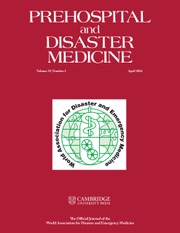Article contents
Revolutionizing Disaster Response Through Real-Time Data and Evaluation
Published online by Cambridge University Press: 21 May 2025
Abstract
Meaningful medical data are crucial for response teams in the aftermath of disaster. Electronic Medical Record (EMR) systems have revolutionized healthcare by facilitating real-time data collection, storage, and analysis. These capabilities are particularly relevant for post-disaster and austere environments. fEMR, an EMR system designed for such settings, enables rapid documentation of patient information, treatments, and outcomes, ensuring critical data capture.
Data collected through fEMR can be leveraged to perform comprehensive monitoring and evaluation (M&E) of emergency medical services, assess operational needs and efficiency, and support public health syndromic surveillance.
Analyzing these data identifies patterns and trends or assesses treatment effectiveness. This insight facilitates data-driven decision-making and the optimization of medical protocols. fEMR’s real-time reports enhance situational awareness and operational coordination among response units. The aggregated data can detect trends, classify case-mix, and facilitate after-action reviews, contributing to continuous improvement in emergency preparedness and response strategies. The system also supports fulfilling reporting requirements for health agencies and funding organizations, ensuring accountability and transparency.
EMRs like fEMR are vital for emergency response teams, supporting immediate patient care and ongoing M&E of disaster response efforts. Its robust data management capabilities support evidence-based practices and strategic planning, improving the effectiveness of emergency medical services in disaster scenarios.
The effective use of fEMR in disaster response scenarios highlights its significance in enhancing operational efficiency, ensuring accountability, and improving the overall effectiveness of emergency medical services through comprehensive data management and real-time reporting.
Information
- Type
- Meeting Abstracts
- Information
- Copyright
- © The Author(s), 2025. Published by Cambridge University Press on behalf of World Association for Disaster and Emergency Medicine
- 1
- Cited by


